Mooring Calculations
Consider a mooring constructed as follows: a 500kg concrete hemisphere anchor/anchor to which is attached 4m of 20mm diameter chain and an additional 7m of 13mm diameter chain. Hale Kai has a length of 9.45m, a beam of 2.75m and a displacement of 6.6t. It is not possible to modify the mooring, at least in the near term.
The Question: Is this mooring suitable?
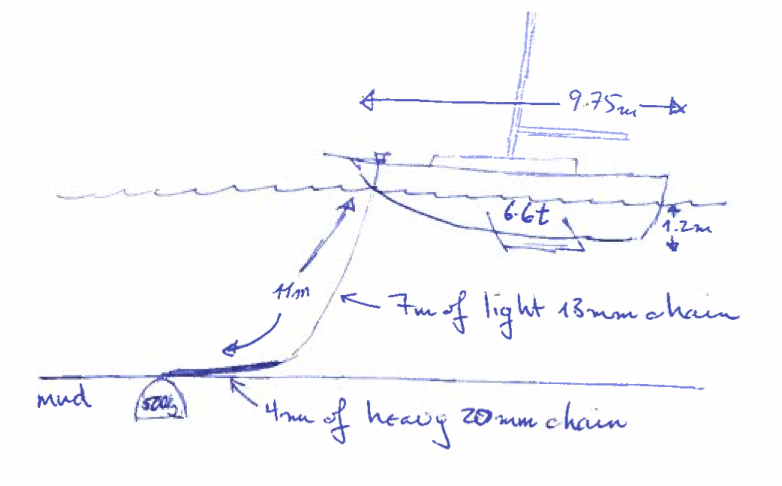
This is an nice physics problem. We need to understand both the steady state behaviour and transient loading due to wind gusts and sudden changes in direction.
Buoyancy of Ground Tackle
- Weight of chain
- Let w13, and m20 be the weight in water per meter of the 13mm and 20mm chain respectively. These values vary slightly by manufacturer, and are specified in air, but conservatively we expect w13 ≈ 2.8kg/m and m20 ≈ 7.5kg/m in air.
- Weight of the anchor
- The weight of the anchor in air is wa = 500kg.
The specific gravity of concrete is SGs ≈ 2.5 and of steel is SGc ≈ 7.5. The definition of specific gravity relative to water is, $$ SG = \frac{\rho}{\rho_\text{water}} $$ where ρwater = 1000kg/m3 is the density of the water, and ρ is the density of the object. We can use this together with Archimedes principle to correct for the effect of buoyancy on the ground tackle. Archimedes principle, the effective weight of an object immersed in water its true mass less the amount of water displaced, $$ w^\prime = w(1 - \frac{\rho_\text{water}}{\rho}) = w(1 - \frac{1}{SG}) $$ The effective weight of the anchor in water revised by this calculation is wa′ = 300kg and the effective weights in water per unit length are w13′ = 2.4kg/m and w20′ = 6.4kg/m for the 13mm and 20mm chains respectively.
This results in a total effective weight of ground tackle of 342kg.
(Strictly speaking we should also correct for the buoyancy of the objects in air, but as the density of air is about 1000 times less than that of water, the difference is only about 0.1% or 3.5kg which we neglect.)
Sustained Winds
The main force pulling against the ground tackle derives from wind. So we need to calculate the wind loading of Hale Kai. For high wind velocities, the force of wind is given by the Lord Rayleigh’s drag equation, $$ F_w = \frac{1}{2}\rho_\text{air} C_D A v^2 $$ where A is the area of the cross-section perpendicular to the wind, CD is the aerodynamic drag coefficient which depends on the shape of the object and its roughness, and v is the wind speed.
Estimating CD for the above-water portion of the hull is complex. Without recourse to complex simulations or experiments, we estimate it as somewhere between a sphere (CD = 0.5) and a streamlined body (CD = 0.04). We will use a value of 0.3. For the mast and rigging, we will use a value of 1.
 The beam of Hale Kai is 9’ or 2.75m. Approximating the cross section as a rectangle of height 1m from the waterline to the top of the coachroof, this gives a cross-sectional area of 2.75m2. The mast is about 10m high and about 0.1m thick. We double this to account for the rigging for a cross-sectional area of 2m2.
The beam of Hale Kai is 9’ or 2.75m. Approximating the cross section as a rectangle of height 1m from the waterline to the top of the coachroof, this gives a cross-sectional area of 2.75m2. The mast is about 10m high and about 0.1m thick. We double this to account for the rigging for a cross-sectional area of 2m2.
Combining these, when the vessel is pointed into the wind, as it will be when the wind is sustained and the system is in equilibrium, and using a wind speed of 33m/s, the force applied to the chain is, $$
F_w = \frac{1}{2}\rho_\text{air}(C_\text{hull}A_\text{hull} + C_\text{rigging}A_\text{rigging})v^2
= \frac{1}{2}\cdot 1.2 (0.4\cdot 2.75 + 1\cdot 2) 33^2 = 1845\text{N} \approx 188 \text{kgf}
$$ 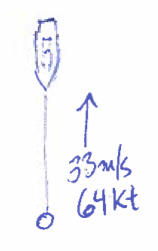 In the worst case, if all of that force is pulling directly upwards on the anchor and chain (an implausible steady state water level of 11m) there is still a safety factor of 1.8 in the static case. Sustained hurricane force winds (Category 1 on the Saffir-Simpson Scale) will not pull the anchor from the bottom. It would take sustained winds of greater than 45m/s (87kt) to do so.
In the worst case, if all of that force is pulling directly upwards on the anchor and chain (an implausible steady state water level of 11m) there is still a safety factor of 1.8 in the static case. Sustained hurricane force winds (Category 1 on the Saffir-Simpson Scale) will not pull the anchor from the bottom. It would take sustained winds of greater than 45m/s (87kt) to do so.
Wind Gusts
As we have seen, for static loading, the shape of the vessel is much more important than its displacement. This is not true of scenarios where the mooring system is experiencing sudden changes. Let us suppose that the system is in equilibrium as above and then a powerful gust of wind of 41m/s arrives perpendicular to the main axis of the boat, on its side.
In this case, the above water profile is more like a rectangle with a drag coefficient CD = 2 and a cross sectional area of 9.45m2, the length of the vessel and the height of the coachhouse roof above the water. This gives, hurricane force wind of 33m/s, $$
F_w = \frac{1}{2} \cdot 1.2 ( 2\cdot 9.45 + 1\cdot 2) 41^2 = 21180\text{N}
\approx 2159 \text{kgf}
$$  This force is resisted by the underwater drag, again modelled as a rectangle of size 8 ⋅ 1.2, the length at the waterline and the draught, $$
F_D = \frac{1}{2} \cdot 1000 \cdot 2\cdot 9.6 u^2
$$ where u is the speed of the boat in the water. We can immediately work out the terminal speed, the maximum possible value for u, when these forces are equal. This turns out to be umax ≈ 1.5m/s.
This force is resisted by the underwater drag, again modelled as a rectangle of size 8 ⋅ 1.2, the length at the waterline and the draught, $$
F_D = \frac{1}{2} \cdot 1000 \cdot 2\cdot 9.6 u^2
$$ where u is the speed of the boat in the water. We can immediately work out the terminal speed, the maximum possible value for u, when these forces are equal. This turns out to be umax ≈ 1.5m/s.
We can proceed numerically to find out how long it takes to reach this terminal velocity. If the gust lasts for some time, t, and the wind remains on the beam, the final speed of the vessel will be, from Newton’s Second Law, $$ a = \frac{F_w - F_D}{m} $$ where m is the mass of the vessel which we will take equal to the displacement, or 6600kg.
f_w :: Double -> Double
f_w w = 0.5 * 1.2 * ( 2.0*9.45 + 2.0) * w^2
f_d :: Double -> Double
f_d u = 1000.0 * 9.6 * u^2
accel :: Double -> Double -> Double
accel w u = (f_w w - f_d u) / 6600.0
integrate :: Double -> Double -> Double -> Double -> (Double, Double)
integrate dt w u t
-- stop when we are within 5% of the wind force
| abs (f_w w - f_d u) < 0.05 * f_w w = (u, t)
| otherwise = integrate dt w (u + dt * accel w u) (t + dt)
main :: IO ()
main = do
print (integrate 0.001 41.0 0.0 0.0)(1.4444449805914912, 1.0099999999999996)Running this program computes the speed that we reach by the time the drag force is within 5% of the wind force and how long this takes. We see that it will take just over a second to reach the terminal velocity. This is essentially instantaneous. This is indeed a powerful gust of wind.
What is the effect of this on the anchor system? By assumption, the system began at equilibrium, with the vessel tethered to the anchor and the gust arrived tangent to the swinging circle imparting a speed of umax = 1.5m/s nearly instantaneously. The boat will swing around the circle to face into the wind, and as it does so, the force of the wind will lessen, reducing to tolerable levels as shown in the static analysis. The greatest load on the anchor system will therefore be at the beginning of the swing with the anchor providing the centrepetal force to keep it on the circle. The magnitude of this force is, $$ F_c = \frac{mu^2_\text{max}}{r} $$ where r is the horizontal distance from the anchor.
If r is 8m, corresponding to a water depth of about 8m, we get a value of Fc = 1856N ≈ 189kgf.
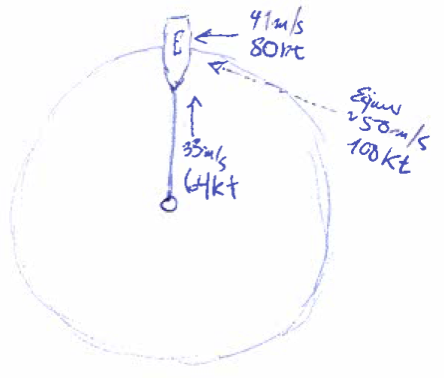 To add this force to the sustained wind force from the 33m/s at equilibrium, we recognise that they are acting at right angles to each other, therefore, $$
F_\text{total} = \sqrt{F_w^2 + F_c^2} = 267\text{kgf}
$$ The total wind speed is is, analogously, 51m/s or about 100kt in a direction about 40 degrees ahead of the beam..
To add this force to the sustained wind force from the 33m/s at equilibrium, we recognise that they are acting at right angles to each other, therefore, $$
F_\text{total} = \sqrt{F_w^2 + F_c^2} = 267\text{kgf}
$$ The total wind speed is is, analogously, 51m/s or about 100kt in a direction about 40 degrees ahead of the beam..
So with sustained winds of 64kt and short gusts of 100ts on the quarter, with a water depth of 8m, we can conclude that the system will hold with a safety factor of 1.3.
Effect of Water Depth
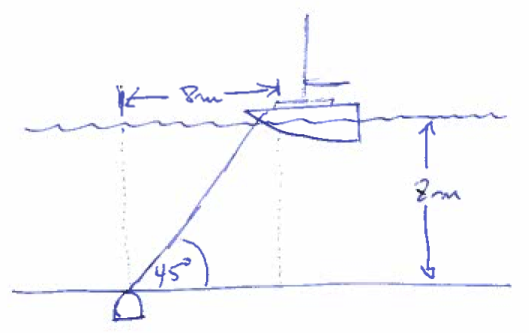 Throughout, we have made the assumption that all of the forces involved are directly transmitted to the anchor, pulling on it in an upwards direction. We can see that this is true for a water depth of 8m, where we can expect an angle of about 45∘ between the chain and the bottom (presuming that it is stretched taut because of wind at the surface).
Throughout, we have made the assumption that all of the forces involved are directly transmitted to the anchor, pulling on it in an upwards direction. We can see that this is true for a water depth of 8m, where we can expect an angle of about 45∘ between the chain and the bottom (presuming that it is stretched taut because of wind at the surface).
The magnitude horizontal force as calculated above is related to the tension in the line, Fhoriz = T cos θ. The magnitude of the vertical force on the anchor is then, $$ F_\text{vert} = T\,\sin\theta = F_\text{horiz}\frac{\sin\theta}{\cos\theta} = F_\text{horiz}\,\tan\theta $$ For θ = 45∘, the vertical and horizontal forces are equal. When $\theta = 64^\degrees$, the vertical force is about double. As θ approaches 90∘, however, the vertical force grows without limit. Actually the limit is the buoyancy of the boat, or 6600kgf, more than enough to lift the anchor.
Thanks to bilge keels, Hale Kai is capable of drying out, happily sitting in the mud. The observed tidal range nearby at Leith is from about chart datum to just over 6m.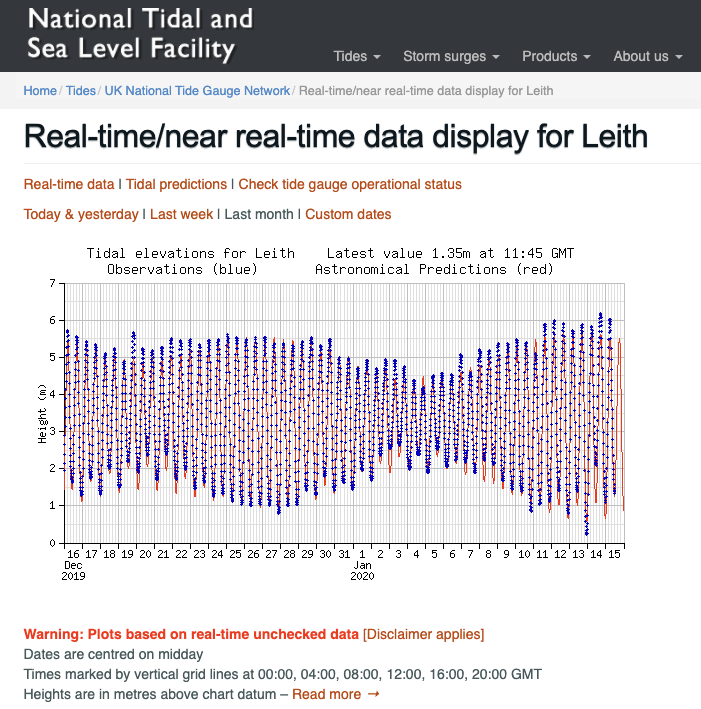
If the mooring is situated so as to just dry out at extreme low spring tides, then a storm surge of 2m on top of a high spring tide can bring the rode angle to 45∘. This corresponds (because tan (45∘) = 1) exactly to the circumstances analysed above.
If, however, the mooring is situated in 1m of water at low tide then such a surge has the following effect. The total depth of the water is now 9m, and with a taut chain, the horizontal distance between the boat and the anchor is 6m. This increases the centripetal force to 232kgf and the angle with the bottom rises to 56∘. The total vertical force on the anchor now becomes,
(188+232) ⋅ tan (56∘) = 623kgf
which is unacceptably high.
To be continued
This static analysis is good as far as it goes. However the anchor rode does not normally form a straight line from the boat and the anchor and this has several consequences. Firstly, the angle between the rode and the sea floor will be as near to horizontal as possible. Secondly, as transient forces cause it to lift, it will resist and pull back, somewhat like a damped spring. The dynamic analysis follows in the next post.
Thanks to Costa and MP4Man for discussing the first draft of this post and spotting embarassing critical errors.